试讲-大学英语教案-第1册第9单元教案
新视野大学英语第一册教案Unit 9

6. Unemployment has come down slightly but this does not a____the fact that it is still a major problem.
strike sb. as sth. 给某人某种感觉或印象
教
e.g. On hearing the soft footsteps outside her room, she was
学
struck with a panic.
内
We were struck dumb with horror.
容
sit back
精讲单 词,反复 练习
alternative ① adj. 其他可以替代的,另一个的
e.g. The alternative book to study for examination is
“War and Peace”.
② n. 另外的选择
e.g. You have the alternative of marrying or remaining
easy/hard, leave whatever you like best until the end.
总结课
Tip3: Read the whole test quickly, focus your attention to finish the 文要点
easier parts before handling hard questions
河北传媒学院 授课教案
unit9教案
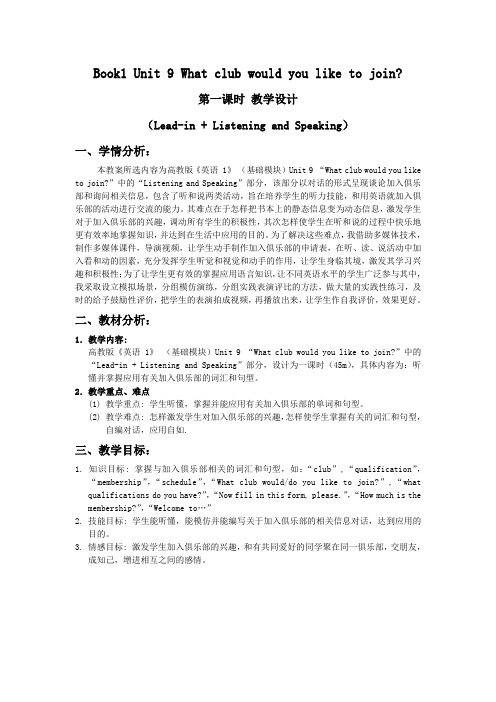
Book1 Unit 9 What club would you like to join?第一课时教学设计(Lead-in + Listening and Speaking)一、学情分析:本教案所选内容为高教版《英语 1》(基础模块)Unit 9 “What club would you like to join?”中的“Listening and Speaking”部分,该部分以对话的形式呈现谈论加入俱乐部和询问相关信息,包含了听和说两类活动,旨在培养学生的听力技能,和用英语就加入俱乐部的活动进行交流的能力。
其难点在于怎样把书本上的静态信息变为动态信息,激发学生对于加入俱乐部的兴趣,调动所有学生的积极性,其次怎样使学生在听和说的过程中快乐地更有效率地掌握知识,并达到在生活中应用的目的。
为了解决这些难点,我借助多媒体技术,制作多媒体课件,导演视频,让学生动手制作加入俱乐部的申请表,在听、读、说活动中加入看和动的因素,充分发挥学生听觉和视觉和动手的作用,让学生身临其境,激发其学习兴趣和积极性;为了让学生更有效的掌握应用语言知识,让不同英语水平的学生广泛参与其中,我采取设立模拟场景,分组模仿演练,分组实践表演评比的方法,做大量的实践性练习,及时的给予鼓励性评价,把学生的表演拍成视频,再播放出来,让学生作自我评价,效果更好。
二、教材分析:1.教学内容:高教版《英语 1》(基础模块)Unit 9 “What club would you like to join?”中的“Lead-in + Listening and Speaking”部分,设计为一课时(45m),具体内容为:听懂并掌握应用有关加入俱乐部的词汇和句型。
2.教学重点、难点(1)教学重点: 学生听懂,掌握并能应用有关加入俱乐部的单词和句型。
(2)教学难点: 怎样激发学生对加入俱乐部的兴趣,怎样使学生掌握有关的词汇和句型,自编对话,应用自如.三、教学目标:1. 知识目标: 掌握与加入俱乐部相关的词汇和句型,如:“club”,“qualification”,“membership”,“schedule”,“What club would/do you like to join?”,“what qualifications do you have?”,“Now fill in this form, please.”,“How much is the membership?”,“Welcome to…”2. 技能目标: 学生能听懂,能模仿并能编写关于加入俱乐部的相关信息对话,达到应用的目的。
《英语1》(基础模块高教版)教案:第九单元第三课时(中职教育).docx

Unit 9 What club would you like to join?(第三课时教学设计)一、教材分析1.教学内容本课时是教材《英语1》(基础模块高教版)第九单元的第三课时,包括language in use and vocabulary practice两部分,具体内容为:一般将来吋的用法和俱乐部屮诘加入相关信息询问的句型,俱乐部相关词汇。
2.教学重点、难点(1)教学重点-般将來时的用法和未來计划的表达,与俱乐部相关的词汇和句型的复习巩固(2)教学难点一般将来时表达未来计划、句型巩固、词汇积累二、教学目标1.知识目标⑴学握与俱乐部相关信息的主耍词汇,如member; form; fill; schedule; certificate;experience; pleasure; staff; excitement; reduce; stress; flash; gain; organization; basic; contact;performance; qualification;(2)掌握参加俱乐部活动短语,如gain experience , enjoy singing , fill in the from , good at playing basketball , reduce stress 、club members are united , offer a chance to experience the pleasure of, welcome to join us ・(3)掌握一般将来时的用法,用一般将来时表达未来计划。
2.能力目标(1)学生能运用相关词汇,句型表达参与俱乐部活动的相关内容。
(2)学生能熟练掌握一般将來时的用法,并川一般将來时表达未來计划。
3 •情感目标学生能根据口己的梦想,制定未来的计划,树立学习的冃标。
三、教学步骤Step one Lead-in (6m)1.Have a comment on the students9 poster. Show some beautiful posters in class・(设计意图:及时评价学生作业,肯定优秀作品,促使学生的学习积极性的提高)2.Have students think about what they will do in the English club and give possible answers. Find out the same structure in these sentences・ They are used to express future activities.English club We will sing English songs・We will listen to English music.We will watch English movies.We will watch English TV programs.We will play English games・We will read English magazines・We will have a competition for English speech・(设计意图:由简单的活动阐述将来会发生的事,对将来事情的主观臆断是将来时态的一种用法之一:Will+动词原形do)Step Two language in use (20m)3.Contrast: give students 4 groups of sentences, then have students talk about the similarities.(1 )What club do you join?What club are you going to join?(2)Tom work in the hospital.Tom is going to work in the hospital.(3)1 do my homework after class. | 〉be going to do (表将来)fm going to do my homework after class ・(4)It rains.It is going to rain.(设计意图:通过内容相同,时态不同的句子相互比较,对比鲜明,学生容易区别其不同之处,掌握一般将来时态的第二种表达be(am is are)going to do,也是计划打算做的事情即将来时态的第二种用法)4.Activity 19 Talk and write: Have students talk about three things they will do after class. Then exchange ideas with their partner.(l)Will you watch TV after class?Yes, I will. / No, I worT匸IT1 do my homework.What are you going to do after class?First, I will---/Fm going to…Next, I will・・・/I'm going to…Then, I will…/IF going to…(2)What is he/she going to do after class?He/she is going lo…(3)What are they going to do after class?They are going to…(4)What will you/he/she/they do after class?I/We/ He / She /They will ...Will you/he/she/they ...?Yes, I/we/he/she/they will.No, I/we/he/she/they wont(设计意图:通过归纳与对比,加深学生印象,使知识结构清晰,便于学生掌握。
英语-Unit-9--教案--第一册--新

【说明】本活动旨在考查学生利用文章内容回答问题的能力,针对不同的问题,从文章中捕捉相关信息,并迅速组织句子给出答案。
Activity 4Fill in the blanks with the words in the box.
【操作】
步骤一:个人活动,学生根据教师的授课内容,用框中单词的适当形式完成句子。
【说明】本活动旨在锻炼学生根据文章上下文猜测生词释义的能力,并增加词汇量。此部分可与“听前准备”一起做。
Activity2Listen and fill in the blanks.
【操作】
步骤一:全班活动,教师再放录音,学生边听录音,边补全空格处的内容。
步骤二:全班活动,教师讲解对话内容,逐句翻译,并抽查学生的答案,作出反馈。
步骤三:全班活动,教师挑选几个学生,检查他们的掌握情况,并作出反馈。
Ⅳ
Text
目的:提高学生的阅读能力,训练学生从文章中获取信息的能力,并为学生完成本部分的学习任务提供语言素材。
A.
阅读前的准备工作。
【说明】你爱吃土豆沙拉吗?自己做过吗?你知道需要哪些原材料,需要哪些步骤和流程?教师请几名学生分享一下自己的经历。
Dumplings饺子
Won tonsoup馄饨
Pekingduck烤鸭
Chowmein炒面
fried shrimps with cashew nuts腰果虾仁
Ⅲ
目的:本活动的目的是让学生掌握和的发音方法,做到发音标准、地道。
【操作】
步骤一:全班活动,教师讲解和的发音方法,并示范发音,学生跟读。
步骤二:全班活动,以适当的单词为例,让学生跟读体会两个音标的发音。
book1 module9 说课教案
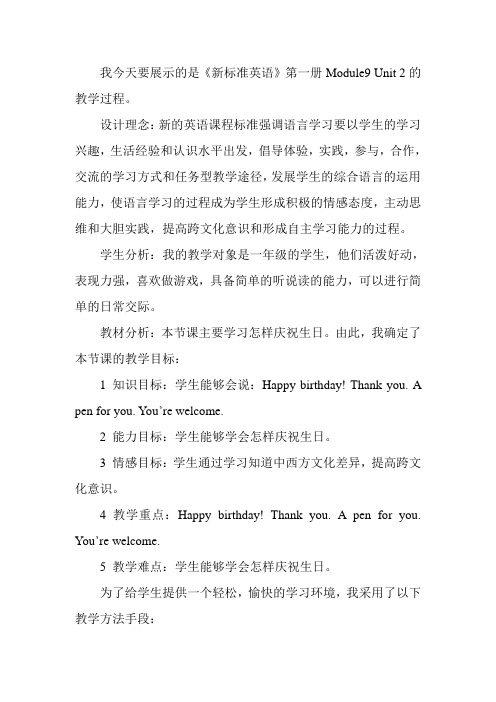
我今天要展示的是《新标准英语》第一册Module9 Unit 2的教学过程。
设计理念:新的英语课程标准强调语言学习要以学生的学习兴趣,生活经验和认识水平出发,倡导体验,实践,参与,合作,交流的学习方式和任务型教学途径,发展学生的综合语言的运用能力,使语言学习的过程成为学生形成积极的情感态度,主动思维和大胆实践,提高跨文化意识和形成自主学习能力的过程。
学生分析:我的教学对象是一年级的学生,他们活泼好动,表现力强,喜欢做游戏,具备简单的听说读的能力,可以进行简单的日常交际。
教材分析:本节课主要学习怎样庆祝生日。
由此,我确定了本节课的教学目标:1 知识目标:学生能够会说:Happy birthday! Thank you. A pen for you. You’re welcome.2 能力目标:学生能够学会怎样庆祝生日。
3 情感目标:学生通过学习知道中西方文化差异,提高跨文化意识。
4 教学重点:Happy birthday! Thank you. A pen for you. You’re welcome.5 教学难点:学生能够学会怎样庆祝生日。
为了给学生提供一个轻松,愉快的学习环境,我采用了以下教学方法手段:1创设一个轻松,真实的学习氛围。
2 采取TPR教学手法,提高学习兴趣。
3 通过任务型教学手段,来完成自由运用语言进行交际的过程。
4 通过小组活动,培养合作精神。
5 多媒体辅助教学。
教学环节:1 热身活动:通过课前小歌谣来复习巩固旧知识,并给学生创设语言氛围。
2 任务呈现:通过为某位学生庆祝生日,导入新课,呈现任务目标。
3 任务启动:通过多种教学形式,让学生主动积极参与到学习中,体验到学习的乐趣,轻松学习。
4 任务完成:通过为某位学生庆祝生日,巩固所学语言知识。
5 拓展部分:通过介绍有关生日知识,提高跨文化意识。
反思:本节课是新授课。
语言点较多,有一定难度。
为了使学生能够在轻松、愉快中学习,我将本课设计成一种任务活动,并通过多种方式调动学生积极性。
电子教案第一册U9-1 Unit 9 Life goes electronic.
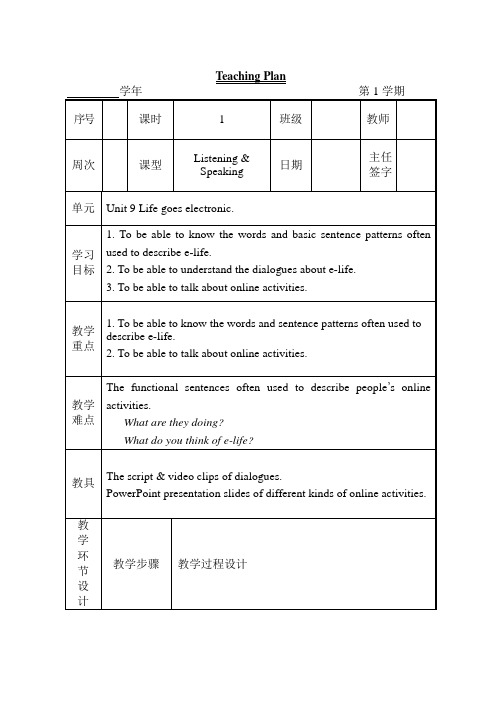
教学 环节 设计
Warming up
Listening & Speaking practice (1)
I. Show the students the picture on Page 9, ask them to look at the picture and discuss: 1. What are they doing? 2. What do you think of e-life?
III. Ask the students to work in pairs and put the sentences in Activity ⑤ in correct order, and make dialogues with the help of the sentences and then act out.
II. Introduce the key themes to the students. III. Ask the students to listen to the sentences and
match the key words in the sentences with the pictures in Activity ①, Warming up. Present the key sentences on the slide and explain their meanings. IV. Ask the students to look at the five pictures in Activity②, and then match the words about e-life with the pictures. I. Ask the students to try reading aloud the words in the word box on Page 91. Then ask them to read the words after the tape. II. Show the picture and tell the students they are
Module9Unit1教案
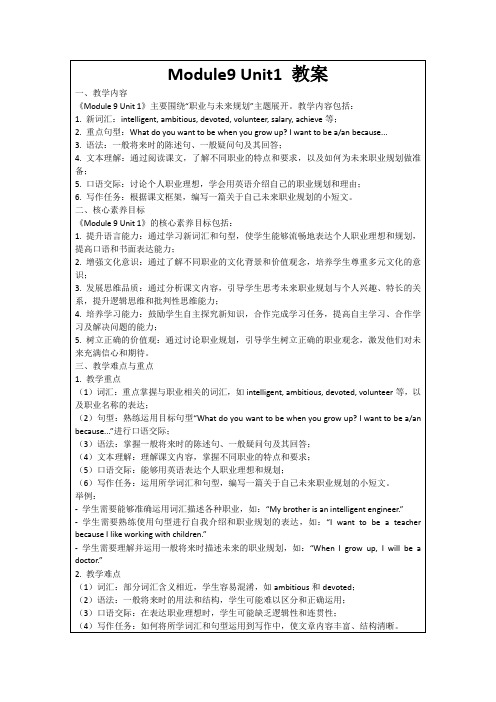
2.教学难点
(1)词汇:部分词汇含义相近,学生容易混淆,如ambitious和devoted;
(2)语法:一般将来时的用法和结构,学生可能难以区分和正确运用;
(3)口语交际:在表达职业理想时,学生可能缺乏逻辑性和连贯性;
(4)写作任务:如何将所学词汇和句型运用到写作中,使文章内容丰富、结构清晰。
难点举例及解释:
-学生可能会混淆“ambitious”和“devoted”两个词,需要通过例句和语境来区分,如:“He is ambitious, always striving for success.”与“She is devoted to her students, caring for their growth.”
4.培养学习能力:鼓励学生自主探究新知识,合作完成学习任务,提高自主学习、合作学习及解决问题的能力;
5.树立正确的价值观:通过讨论职业规划,引导学生树立正确的职业观念,激发他们对未来充满信心和期待。
三、教学难点与重点
1.教学重点
(1)词汇:重点掌握与职业相关的词汇,如intelligent, ambitious, devoted, volunteer等,以及职业名称的表达;
1.提升语言能力:通过学习新词汇和句型,使学生能够流畅地表达个人职业理想和规划,提高口语和书面表达能力;
2.增强文化意识:通过了解不同职业的文化背景和价值观念,培养学生尊重多元文化的意识;
3.发展思维品质:通过分析课文内容,引导学生思考未来职业规划与个人兴趣、特长的关系,提升逻辑思维和批判性思维能力;
3.重点难点解析:在讲授过程中,我会特别强调一般将来时的用法和职业相关词汇这两个重点。对于难点部分,我会通过举例和比较来帮助大家理解。
《英语1(基础模块)》电子教案(教学设计)Unit 9
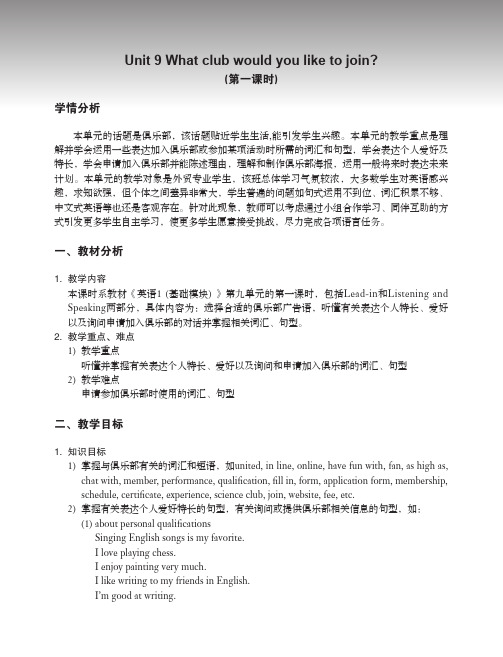
137 Unit 9 What club would you like to join?(第一课时)学情分析本单元的话题是俱乐部,该话题贴近学生生活,能引发学生兴趣。
本单元的教学重点是理解并学会运用一些表达加入俱乐部或参加某项活动时所需的词汇和句型,学会表达个人爱好及特长,学会申请加入俱乐部并能陈述理由,理解和制作俱乐部海报,运用一般将来时表达未来计划。
本单元的教学对象是外贸专业学生,该班总体学习气氛较浓,大多数学生对英语感兴趣,求知欲强,但个体之间差异非常大,学生普遍的问题如句式运用不到位、词汇积累不够、中文式英语等也还是客观存在。
针对此现象,教师可以考虑通过小组合作学习、同伴互助的方式引发更多学生自主学习,使更多学生愿意接受挑战,尽力完成各项语言任务。
一、教材分析1. 教学内容本课时系教材《英语1 (基础模块) 》第九单元的第一课时,包括Lead-in和Listening and Speaking两部分,具体内容为:选择合适的俱乐部广告语,听懂有关表达个人特长、爱好以及询问申请加入俱乐部的对话并掌握相关词汇、句型。
2. 教学重点、难点1) 教学重点听懂并掌握有关表达个人特长、爱好以及询问和申请加入俱乐部的词汇、句型2) 教学难点申请参加俱乐部时使用的词汇、句型二、教学目标1. 知识目标1) 掌握与俱乐部有关的词汇和短语,如united, in line, online, have fun with, fan, as high as,chat with, member, performance, qualification, fill in, form, application form, membership,schedule, certificate, experience, science club, join, website, fee, etc.2) 掌握有关表达个人爱好特长的句型,有关询问或提供俱乐部相关信息的句型,如:(1) about personal qualificationsSinging English songs is my favorite.I love playing chess.I enjoy painting very much.I like writing to my friends in English.I’m good at writing.138英语1(基础模块)电子教案(2) asking for informationWhat club do you like to join?What qualifications do you have?Now fill in this form, please.(3) giving informationI’m a member of the English club.Y ou can go to the club website to check the schedule.2. 能力目标1) 学生能听懂有关加入俱乐部和询问相关信息的对话;2) 学生能用所学句型简单表达个人的爱好、特长;3) 在日常生活中灵活应用学到的关键句型。
英语基础模块1 Unit 9 说课
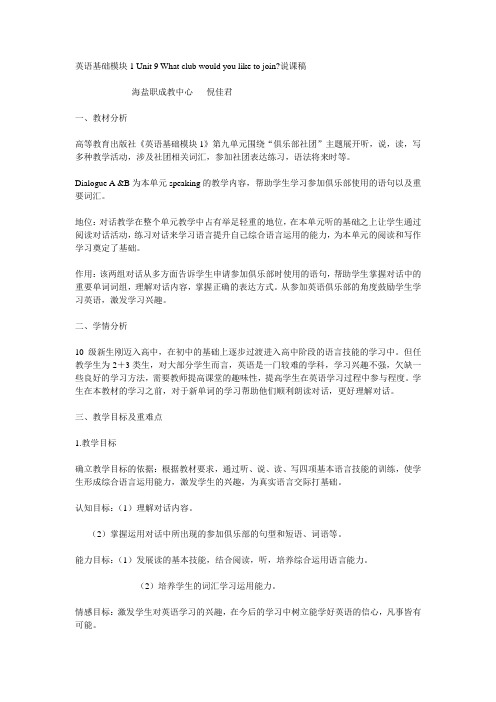
英语基础模块1 Unit 9 What club would you like to join?说课稿海盐职成教中心倪佳君一、教材分析高等教育出版社《英语基础模块1》第九单元围绕“俱乐部社团”主题展开听,说,读,写多种教学活动,涉及社团相关词汇,参加社团表达练习,语法将来时等。
Dialogue A &B为本单元speaking的教学内容,帮助学生学习参加俱乐部使用的语句以及重要词汇。
地位:对话教学在整个单元教学中占有举足轻重的地位,在本单元听的基础之上让学生通过阅读对话活动,练习对话来学习语言提升自己综合语言运用的能力,为本单元的阅读和写作学习奠定了基础。
作用:该两组对话从多方面告诉学生申请参加俱乐部时使用的语句,帮助学生掌握对话中的重要单词词组,理解对话内容,掌握正确的表达方式。
从参加英语俱乐部的角度鼓励学生学习英语,激发学习兴趣。
二、学情分析10级新生刚迈入高中,在初中的基础上逐步过渡进入高中阶段的语言技能的学习中。
但任教学生为2+3类生,对大部分学生而言,英语是一门较难的学科,学习兴趣不强,欠缺一些良好的学习方法,需要教师提高课堂的趣味性,提高学生在英语学习过程中参与程度。
学生在本教材的学习之前,对于新单词的学习帮助他们顺利朗读对话,更好理解对话。
三、教学目标及重难点1.教学目标确立教学目标的依据:根据教材要求,通过听、说、读、写四项基本语言技能的训练,使学生形成综合语言运用能力,激发学生的兴趣,为真实语言交际打基础。
认知目标:(1)理解对话内容。
(2)掌握运用对话中所出现的参加俱乐部的句型和短语、词语等。
能力目标:(1)发展读的基本技能,结合阅读,听,培养综合运用语言能力。
(2)培养学生的词汇学习运用能力。
情感目标:激发学生对英语学习的兴趣,在今后的学习中树立能学好英语的信心,凡事皆有可能。
2. 教学重难点重点:(1)帮助学生掌握对话主要信息。
(2 ) 帮助学生有效学习对话中词汇以及重要表达方式。
Module9Unit1教案

在课堂总结环节,我发现部分学生对所学知识点的掌握不够扎实。为了帮助学生更好地巩固知识,我计划在课后增加一些针对性的练习,并及时给予反馈,让学生了解自己的学习进步。
-增强学生关爱地球、保护环境的责任感,培养良好的人文-词汇:本节课的核心词汇包括ocean, continent, mountain, forest, desert等,这些词汇是描述地球地理特征的基础,需要学生熟练掌握。
-语法:一般现在时的使用是本节课的重点,学生需要学会如何使用这个时态来描述地球的自然现象和特征。
-完成课后练习,巩固所学知识。
二、核心素养目标
1.思维品质目标:
-培养学生运用英语进行逻辑思维和批判性思维的能力,通过分析课文内容,对地球的环境问题进行思考,提出自己的见解。
-鼓励学生在讨论中发表个人观点,提高解决问题的能力。
2.文化意识目标:
-增进学生对地球环境的了解,培养全球意识,尊重不同文化背景下的环境保护观念。
-能够运用目标词汇描述地球上的不同地理特征。
-提高学生的听说能力和小组合作能力。
3.情感目标:
-增强学生对地球环境保护的意识。
4.教学内容:
-课文阅读:学习描述地球的自然现象和特征。
-语法点:一般现在时。
-口语练习:讨论地球的地理特征和保护地球的方法。
-写作练习:撰写关于地球的短文。
5.课后作业:
-复习本节课学习的词汇和语法。
Module 9 Unit1教案
一、教学内容
Module 9 Unit1《Our Earth》
新视野大学英语1(高职高专教材)第九单元说课稿

CommunicativeApproach(交际教学法);
Situtional Language Teaching method(情景教学);
Question-answer Teaching Approach.(问题教学法);
Teachingobjectives:
1.InReadinganБайду номын сангаас Writing, students will be able to:
① identify the main idea of theText Aandanalyze some difficult sentences and some language points;
新视野大学英语1(高职高专教材)第九单元说课稿
Unit9 New Jobs Today
Good afternoon, laddies and gentlemen! It’s my great pleasure to be here sharing my lesson with you.The content of my lesson is New Horison English course Book 1 Unit 9(New Jobs Today).I’ll be ready to begin this lesson from five parts:Analysis of the teaching material, the teaching methods, the studying methods, the teaching procedure,and Blackboard design.First, let me talk about the teaching material.
大学英语精读第一册电子教案Unit9 Is There Life On Earth

Before Reading
Global Reading
Detailed Reading
After Reading
Art Buchwald
(1925- ) A a well-known American humor columnist for Washington Post. His columns frequently deal with stories about politicians and famous personalities, current events in politics and issues in the news.
Before Reading
Global Reading
Detailed Reading
After Reading
Directions:
Group Discussion Some tsunami survivors, when they recall the terrifying moments, say that they seemed to have experienced what is described in the Hollywood movie The Day After Tomorrow. So either the real tsunamis or the fictional movies make us rethink the relationship between humans and nature.
Before Reading
Global Reading
Detailed Reading
After Reading
1. Warm-up Questions 2. Word-web
新编英语教程第三版第一册unit9

新编英语教程第三版第一册unit9Unit 9Language StructureMain Teaching Points: The adverbial clause1.of time introduced by while/as soon as/ the moment/ by the timee.g. 1) Tom walked in while I was typing in the office.2) As soon as / The moment he came in, he asked for the file on the production quota.3) By the time I got everything ready for him, (however), he’d gone.2. of time and place introduced by whenever/and where; of concession introduced by however; of time/cause introduced by now thate.g. 1) Whenever and wherever I see Sid, I tell him how harmful smoking is.2) (But ) However hard I try to persuade him to give up smoking, he just won’t listen.3. of condition introduced by or else; of purpose introduced by so (that)e.g. Now that you’ve started it, you’d better go on with it, or else you’ll regret it afterwards.(Yes.) We will go on with it, so (that) we shall not regret it afterwards.4. of manner introduced by as if/ as though, indicating an unreal situation; of time/ condition introduced by so long as/ as long ase.g. 1) Jack acted as if /as though nothing had happened.2) He didn’t worry so long as / as long as there was stillfinding then.5. of degree introduced by so far as; of alternative condition introduced by whether… or note.g. 1) So far as I know, Fanny’s not coming to the meeting.2) But whether she’s coming or not, we won’t wait.Useful expression1.loaf away one’s time :loaf about/around v.游手好闲,无所事事;闲荡e.g. A group of kids were loafing around outside.一群小孩在外面四处游荡。
新技能英语 基础教程1教学设计Unit 9 Life goes electronic.
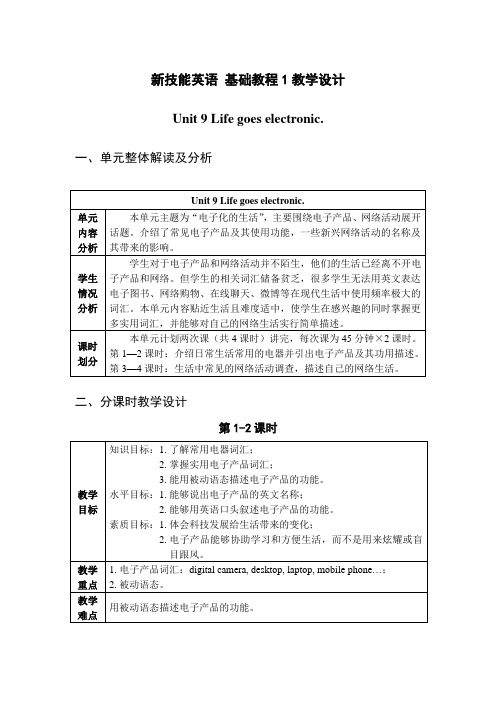
(说出能够加两分)
3.老师随机挑选几名学生描述自己的网络生活,最少说一句,说得越具体越好。例如:
Ilikeshoppingverymuch.AndIusuallyshoponlineathome.Shoppingonlineisverycheap.Anditcansavealotoftime.Doyoulikeshoppingonline?
学生回答:
mobilephone!
computer!
(手机!电脑!)
积极思维,开拓思路。
学生回答:
网络!
Internet!
学生回答:
听歌!
看小说!
淘宝!
温故而知新。
简单提问能够吸引绝大部分学生的注意力。
开放性的提问更能激发学生的思考活力。
从电子产品能够较顺利地过渡到网络的话题。
提到网络,学生们肯定有很多话说。
laptop
digitalcamera
mobilephone
2.提问2:
Sowhichtwoelectronicproductsinyourmindarethemostusefulandpopularinourdailylife?(哪两种电子产品是现在使用最广泛的呢?)
3.提问3:
Whyaremobilephonesandcomputerssopopularnowadays?(为什么手机和电脑成为了当前使用最广泛的电子产品呢?)
b.传真机能够用来传送文件。
Thefaxmachinecanbeusedtosenddocuments.
第3-4课时
教学
目标
知识目标:1.了解日常网络活动的英文表达;
Module9Unit1教案
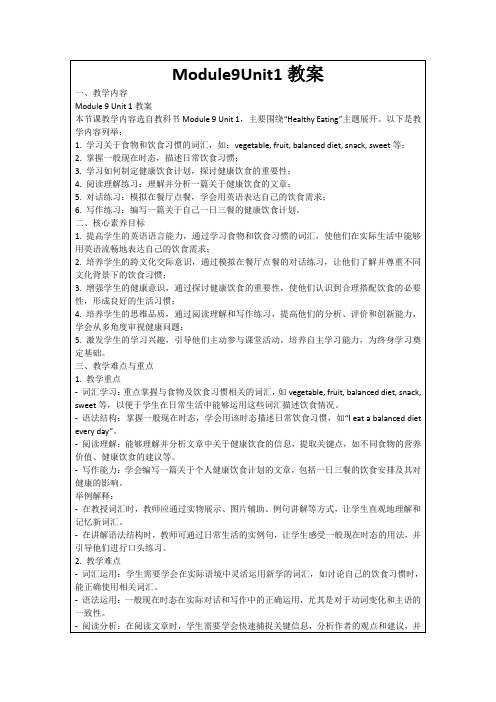
-阅读分析:在阅读文章时,学生需要学会快速捕捉关键信息,分析作者的观点和建议,并形成自己的见解。
-写作构思:学生在编写饮食计划时,难点在于如何合理组织文章结构,清晰表达自己的观点,并注意语言表达的准确性。
举例解释:
3.成果分享:每个小组将选择一名代表来分享他们的讨论成果。这些成果将被记录在黑板上或投影仪上,以便全班都能看到。
(五)总结回顾(用时5分钟)
今天的学习,我们了解了健康饮食的基本概念、重要性和应用。同时,我们也通过实践活动和小组讨论加深了对健康饮食的理解。我希望大家能够掌握这些知识点,并在日常生活中灵活运用。最后,如果有任何疑问或不明白的地方,请随时向我提问。
3.重点难点解析:在讲授过程中,我会特别强调一般现在时态和食物词汇这两个重点。对于难点部分,我会通过例句和练习来帮助大家理解。
(三)实践活动(用时10分钟)
1.分组讨论:学生们将分成若干小组,每组讨论一个与健康饮食相关的实际问题,如如何制定一日三餐的饮食计划。
2.实验操作:为了加深理解,我们将进行一个简单的实验操作,比如制作一份健康沙拉,演示如何搭配食物。
2.培养学生的跨文化交际意识,通过模拟在餐厅点餐的对话练习,让他们了解并尊重不同文化背景下的饮食习惯;
3.增强学生的健康意识,通过探讨健康饮食的重要性,使他们认识到合理搭配饮食的必要性,形成良好的生活习惯;
4.培养学生的思维品质,通过阅读理解和写作练习,提高他们的分析、评价和创新能力,学会从多角度审视健康问题;
1.关注每一位学生,鼓励他们积极参与课堂讨论;
2.加强教学难点和重点的讲解,提供更多实际案例和练习;
3.丰富实践活动,加入更多与课程相关的知识,提高学生的实际操作能力;
第1册.9单元教案

Step 6. Group Assessment &Self-check 3mins Activity9 Assessment 1. Group Assessment Ask Ss to give each group a score according to the standard, and choose “The Best Group”. 2. Self-check Ask Ss to give themselves a score according to the contents in the sheet.
教学重点
Understand the structures and expressions about joining a club.
教学难点
Suggest a proper clubs with useful expressions according to
the given situation.
板书设计 Unit 9. What club would you like to join?
Key phrases:
Key structures:
be good at I’d like to
fill in join the club
What club do you like to join? I’d like to join the…club.
clubs.
教学方法
Listening, speaking, working in pairs.
教学手段
Multi-media, Internet, E-blackboard, and Computer.
教学过程 教学环节与时间分配
Step 1 3mins
book1 unit9 section1a-1c教案(1)
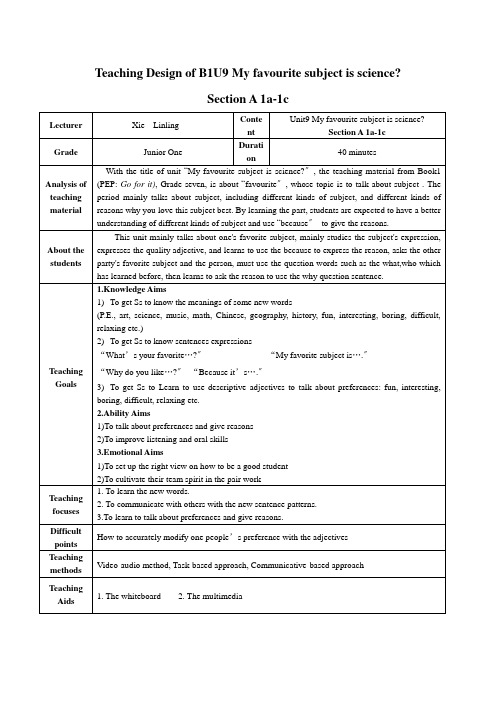
3.Encourage a student to do the chant.Remind them of the PK
4.Tell them to play a game called“good eyes〞
1.Spell the new words and follow me to readthe new words
1.Practice the target language in the third person.
2. Trainstudents’
communicative
ability and
develop their
cooperative and
competitive
spirits.
3.Arouse their interest.
Difficult points
How to accurately modify one people’s preference with the adjectives
Teaching methods
Video-audio method, Task-based approach, Communicative-based approach
1.Learn the target
language
2.Train students’
communicative
ability and
develop their
cooperative and
competitive
spirits.
Step5
Presenta
tion(3)
1. Introduce my students to them.Listen to them and then I ask them some questions about my students:what’s his/her favorite subject?why does he/she like it?
- 1、下载文档前请自行甄别文档内容的完整性,平台不提供额外的编辑、内容补充、找答案等附加服务。
- 2、"仅部分预览"的文档,不可在线预览部分如存在完整性等问题,可反馈申请退款(可完整预览的文档不适用该条件!)。
- 3、如文档侵犯您的权益,请联系客服反馈,我们会尽快为您处理(人工客服工作时间:9:00-18:30)。
Book1Unit9 Is there life on Earth?Teaching Hours: 50 minutesStudents’ Level:freshmen of non-English majors in the 1st semester.Teaching Objectives:1.About the warming-up, get students know something about environmentpollution and protection.2.About background knowledge, get students know some information about theeight planets in solar system especially the Venus and the Earth.3.About the global reading, students are supposed to have a good understanding ofthe text, not only capable of finding out answers about comprehension questions but also able to summarize the main idea of the text.4.About the classroom presentation, students are to practice their spoken Englishthrough a given topic.Key Teaching Points:1. Bad effects of environment pollution and some ways of environment protection.2. The development, structure and the main idea of the story.Teaching Procedures:Part I Warm-up Questions (10mins)Ask students some questions as a lead-in to the text.1. Women used to be referred to as the weaker sex. What do you think?2. Do you think there is real equality between the sexes in present-day China?3. Who is the heroine you admire most? Give your reasons.Part II Background information (10mins)1. Eight Planets in the Solar SystemThey are Mercury, Venus, Earth, Mars, Jupiter, Saturn, Uranus, Neptune, and Pluto.2. VenusVenus is the second planet in distance from the sun and nearest to the Earth of all the planets in the solar system. Except for the sun and the moon, Venus is the brightest object in the sky. The planet is called “the morning star” when it appears in the east in the sunrise, and “the evening star” when it is in the west at sunset.The surface temperature of Venus averages about 475 degrees centigrade and its atmosphere is about 95% carbon dioxide (CO2). Oxygen is rare there. The high temperature and near absence of oxygen on Venus make it unlikely that life as we know it could exist there.It is satirically interesting that Art Buchwald has chosen the planet Venus as the setting for his story. His satire is most deeply felt when he has the Venusian professor say that if the Venusians can learn to breathe in an Earth atmosphere, then they can live anywhere else.3. EarthThe earth is the third planet in the system and the moon is always circling around it. It looks like a big blue marble; from high above the Earth and from the moon, the planet gleams and shines. It’s really a beautiful planet, but her beauty is not only because of the view, but also her vitality.The earth, the planet we human have been living on for thousands of years, is the only planet whose environment is suitable for creatures in the solar system. The earth is the cradle of life. It’s high time that we took actions to protect our planet. Part Three Global Reading (20mins)1. Introductory RemarksThis is a science fiction story, isn’t it? The title “Is there life on Earth?” produces a strong air of humor, arousing readers’interest immediately. Surely, you will enjoy your reading.1) Questions about the Text① What caused the excitement on the planet Venus?For the first time Venusian Scientists managed to land a satellite on the planet Earth, and it has been sending back signals as well as photographs ever since.②What led the Venusian scientists to believe that there’s no life on Earth?For one thing, Earth’s surface in the area of Manhattan is composed of solid concrete and nothing can grow there. For another, the atmosphere is filled with carbon monoxide and other deadly gases and nobody could possibly breathe this air and survive.”③Why does professor Zog think it impossible to land a flying saucer on Earth without its being smashed?There’re metal particles that move along certain paths. They emit gases, make noise and keep crashing into each other. There are so many of these paths and so many metal particles that it is impossible to land a flying saucer without being smashed by one.2) Structure of the TextWhile global reading, students should be able to work out the structure of the text. Part I (Para 1-3)A press conference was held at the Venus Institute of Technology.Part II (Para 4-15)Reasons why there’s no life on EarthP art III (Para 9-10)Decisions that they would proceed their flying saucer program.3) The Main Idea of the StoryThe author has meant this essay to appear as a piece of science fiction, a story taking place on the planet Venus. It is written from the point of view of “Venusians”who are exploring the possibility of life on Earth. On a press conference held at the Venus Institute of technology, professor Zog declared that there’s no life on Earth because of various problems found on Earth such as too much solid concrete, deadly atmosphere, and polluted water. In this way, the author implies that pollution on our earth is very severe, and it’s high time we did something to stop it.Part Four Classroom presentation (10 mins)One or two students are expected to give a classroom presentation on the given topic of “environment problems of today's China (such as the dust storm in Aksu Region).”Example:Dust storms can carry large amounts of dust, which can sweep across whole Aksu Region in April and May.Dust storms have also been shown to increase the spread of disease across the world. Virus spores in the ground are blown into the atmosphere by the storms with the minute particles and interact with urban air pollution. In addition, dust storms also reduce visibility affecting aircraft and road transportation. Many people are hurt during dust storms by automobile accident.The effects of dust storms can be reduced by using environmental control strategies. Take appropriate control of dust raising factors such as increasing the vegetation cover where possible. It helps in stabilization of the soil, sand dunes and form windbreaks。
